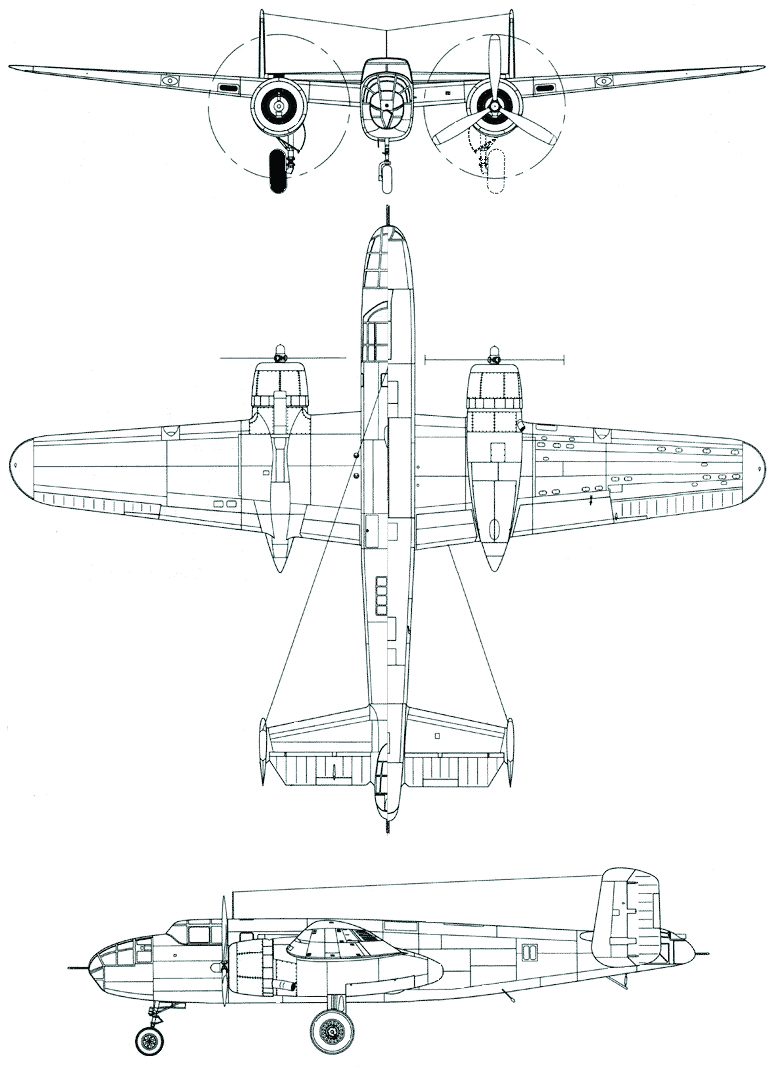Widely considered a reliable and durable aircraft, the Mitchell was operated in every theater of the Second World War.
Developed from the NA-40 attack bomber, the B-25 twin-engine aircraft first took flight in 1940 and was used during World War II—one of America’s most famous airplanes during this conflict. It was the type used by Gen. Jimmy Doolittle for the Tokyo Raid on April 18, 1942. The B-25J is an improved H version with an overhauled nose, alternate armament and restored co-pilot’s seat with dual flight controls. With the addition of what was known as a strafer nose, many of the B-25J aircraft were used in strafing missions—low-lying ground attacks. Production of these aircraft ended in 1945 after 4,400 had been built.

Serial Number: 44-86772
Manufacturer: North American Aviation
Crew: Five
Engines: Two Wright R-2600-13 Double Cyclone radial; 1,700 horsepower each
Wingspan: 67 feet 7 inches
Length: 53 feet 5 3/4 inches
Height: 16 feet 4 3/4 inches
Weight: 21,100 pounds (empty); 33,500 pounds (loaded); 41,800 pounds (maximum)
Speed: 230 mph (cruising); 303 mph (maximum)
Range: 2,700 miles
Service Ceiling: 24,200 feet
Armament: Eighteen .50-caliber machine guns; 3,200-pound bombs or one 2,000-pound torpedo
Cost: $142,194 (average B-25 cost of unit as of 1944)
During World War II, Hill Air Force Base performed maintenance and overhaul for B-25 engines, as well as performed storage and reclamation efforts. Later, the base modified B-25s for the Korean conflict. The B-25J on display was manufactured in 1945.
Our B-25 at Hill Aerospace Museum was first accepted by the United States Air Force (USAF) in June 1945 and was immediately placed into storage. It was moved around between various maintenance and storage fields in California, Missouri and Texas. In January 1950 it was assigned to the 1050th Maintenance Service Unit at Andrews Air Force Base (AFB). In August 1952, the aircraft was transferred to the 1401st Air Base Wing Utility also at Andrews AFB.
After two years, the aircraft was sent to Birmingham, Alabama for Hayes conversion and then returned to Andrews AFB. In December 1957, the B-25 became part of the 1001st Air Base Wing, still at Andrews AFB, but was transferred to Davis-Monthan AFB for long-term storage a year later. It was declared surplus to the USAF needs and that summer it was sold to National Metals in Phoenix, Arizona.
In January 1962, the aircraft made a forced landing in a farmer’s field in Argentina after suffering either engine problems or running out of fuel. The aircraft was apparently being used to smuggle cigarettes into Argentina from Paraguay at the time of the incident. It landed in a rough field and the nose wheel collapsed, causing damage to the front of the aircraft.
It was then donated to a local flying club, where it was moved to a nearby airfield for display. Then a letter was sent to the Federal Aviation Administration (FAA) in November 1964, requesting that the aircraft’s registration be cancelled since it was permanently out of service. The registration was cancelled the next month and it sat at the small airfield in Argentina for the next 27 years.
In 1990, Don Whittington of Fort Lauderdale, Florida obtained the aircraft, and it sat in pieces in his hangar until 1993. The aircraft was reassembled and restored, and Mr. Whittington traded the B-25 to the United States Air Force Museum System for four H-1 helicopters. The Mitchell was assigned to Hill Aerospace Museum for permanent display and was painted to resemble the B-25s flown by the “Air Apaches” of the 345th Bombardment Group.
Widely considered a reliable and durable aircraft, the Mitchell was operated in every theater of the Second World War.
Built as a medium bomber, the B-25 would later be reconfigured to fill a multitude of roles including as a gunship, strafing aircraft and as transportation.
The Mitchell was one of the first bombers to include the use of a tail gun to help aircraft survivability from enemy aircraft who regularly used the defenseless rear to make strafing runs.
Just four months after the devastating attack on Pearl Harbor, 16 B-25s made a successful attack against mainland Tokyo. Though the actual damage was minimal, the psychological effect was incalculable.
Of the 80 airmen who took part, 69 would return to active duty by war’s end. Of the 16 aircraft, only one landed intact in Siberia. The majority were lost across mainland China.